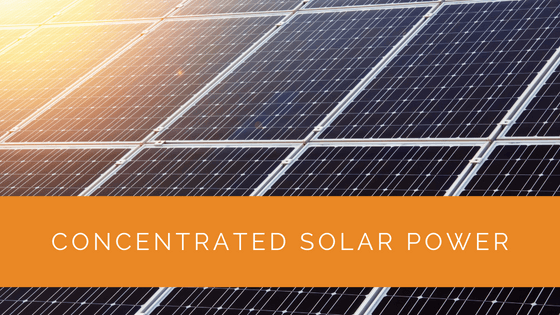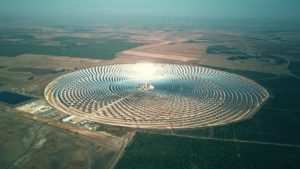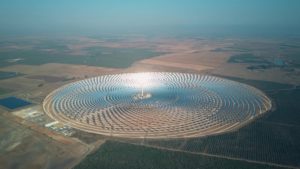Concentrated Solar Power (CSP) represents a groundbreaking leap forward in renewable energy technology, capturing the immense power of the sun to generate electricity. This article explores the fascinating world of CSP systems, diving deep into their mechanisms, various technologies involved, and their potential impact on our energy future. With a focus on clarity and accessibility, we’ll uncover the strengths, limitations, and the pivotal role CSP plays in a sustainable energy landscape. Whether you’re a renewable energy enthusiast or simply curious about this innovative technology, join us to learn about the transformative power of mirrors in concentrated solar energy. Contents CSP systems concentrate sunlight onto a receiver, converting it into heat. The heat is then transformed into steam, driving a turbine that generates electricity. CSP plants often incorporate thermal energy storage systems to store heat energy for later use, ensuring a steady power supply even when sunlight is scarce. These systems can also be integrated with other power sources to create hybrid facilities. For example, CSP can work alongside thermal power blocks that burn coal, non-renewable fuels, or biofuels. Parabolic Trough Systems: These systems use curved, trough-shaped mirrors to focus sunlight onto a receiver tube containing heated thermal oil. The oil is then used in a solar steam engine thermal power block to generate electricity. Power Tower Systems: These systems track the sun and direct its energy onto a receiver at the top of a tower using heliostat mirrors. The heat generated boils a fluid, which drives a turbine connected to a generator. Linear Fresnel Systems: These systems use linearly arranged mirrors to focus sunlight onto a receiver tube above them. Similar to parabolic troughs and power towers, they can effectively produce steam or store thermal energy. Parabolic Dish Systems: These systems use a dish-shaped mirror to concentrate sunlight onto a receiver located at the focal point. The heat collected can drive a heat engine, reaching extremely high temperatures suitable for solar thermal reactors. Here are some key advantages of concentrated solar energy. Despite its many advantages, CSP plants face several challenges. First, their feasibility depends heavily on location. Like solar PV and wind energy, CSP plants require significant land area, making them economically impractical in densely populated regions. Here are some additional drawbacks of this energy system. The efficiency of a concentrated solar power (CSP) plant depends on several factors, including the type of commercial operation, the heat transfer fluid, and the flat mirrors used. However, most CSP installations typically generate power between 7% and 25% efficiency. In comparison, hydropower systems can reach efficiencies of up to 90%, while steam turbines can achieve energy savings of up to 59%. Solar photovoltaic panels also perform well, with many achieving efficiencies ranging from 14% to 23%. Global CSP installations have grown significantly over the years. Spain leads the way with the world's largest CSP plants, accounting for more than 42% of all CSP installations and power generation. The PS10 (Planta Solar 10) in Spain was one of the earliest commercial utility-scale projects, utilizing flat mirror strips. Through a ten-year infrastructure plan, the country aims to quadruple its CSP output to 4.8 GW by 2025. The Ouarzazate Solar Power Station in Morocco, with a capacity of 510 MW, is currently the most prominent CSP system. It consists of three plants and began operations in 2016 using the parabolic trough method. Approximately 1.1 million Moroccans depend on it for electricity. Meanwhile, the Moroccan plant is expected to be surpassed by Noor Energy 1, a 700 MW CSP plant under development in Dubai. Combining parabolic trough and power tower technology, the project is scheduled for completion in 2022 and will be part of Dubai’s 'Vision 2022' initiative for sustainable and eco-friendly growth. The United States is also recognized for its CSP operations, with 52 projects in operation, the largest being the 392 MW Ivanpah installation in California. However, no new CSP initiatives have been announced in the U.S. since 2016. Although the global solar industry has grown rapidly in recent years, CSP still faces several hurdles. Building CSP plants is costly, and their operational expenses are high, leaving limited funding for new and upcoming projects. However, as the CSP distribution network expands and investors recognize its potential, costs may decline, brightening the future of concentrated solar power. According to the International Energy Agency, reducing atmospheric CO2 levels to below 2 degrees Celsius is crucial to keeping global temperatures in check. Concentrated solar power seems poised to play a vital role in achieving this goal. Experts are investigating methods to remove CO2 directly from the air, utilizing amino acid chemistry. Climeworks, a company specializing in direct air capture, has developed a carbon removal technique powered by moderate flames to absorb atmospheric carbon dioxide using filters. Concentrated Solar Power (CSP) represents a major advancement in harnessing solar energy. By focusing sunlight using mirrors, CSP systems can generate substantial amounts of electricity, providing a stable and reliable energy source. The technology’s potential for thermal energy storage further enhances its ability to deliver power even when the sun isn’t shining. Renewable Energy Specialist CSP has the unique advantage of integrating with traditional power plants, which can utilize fossil fuels or biofuels to form hybrid systems. This flexibility makes CSP an attractive option for transitioning to cleaner energy sources while maintaining grid stability. Environmental Engineer While CSP systems show promise, their high initial costs and water usage remain significant challenges. However, as the technology matures and becomes more efficient, we can expect these barriers to diminish, making CSP a more viable option for large-scale renewable energy production. Energy Policy Analyst Are you navigating the world of solar installations? Look no further than Solar Panels Network, the UK’s trusted partner in harnessing the sun’s potential. Our commitment extends beyond installations—we’re dedicated to transforming how homeowners and businesses across the UK perceive and utilize energy. By choosing us, you’re reducing your carbon footprint and making a smart financial move that promises savings for years to come. Contact us today and embark on your solar journey. In summary, mirrors in Concentrated Solar Power (CSP) systems focus sunlight to generate heat, which is then converted into electricity by spinning a turbine. This article has covered everything you need to know about CSP plants, including their functionality, advantages, and limitations. You’re now equipped to discuss this futuristic energy source and possibly consider investing in one. Solar Panels Network stands at the forefront of solar energy solutions, led by a team of experienced solar engineers and energy consultants. With decades of experience in delivering high-quality solar installations and maintenance, we are committed to promoting sustainable energy through customer-centric, tailored solutions. Our articles reflect this commitment, crafted collaboratively by experts to provide accurate, up-to-date insights into solar technology, ensuring our readers are well-informed and empowered in their solar energy decisions. Drill bits are cutting tools used to remove material to create holes, almost always of circular cross-section. Drill bits come in many sizes and shapes and can create different kinds of holes in many different materials. In order to create holes drill bits are usually attached to a drill, which powers them to cut through the workpiece, typically by rotation. The drill will grasp the upper end of a bit called the shank in the chuck. Drill Bits,Drill Bit Set,Drill Bit Types,Diamond Drill Bit Shenyang Lubang Railway Maintenance Machinery Co.,Ltd. , https://www.srmfrailwayequip.com
Key Takeaways
How Do Concentrated Solar Power Systems Work?

Four Categories of CSP Technology
Benefits of Concentrated Solar Energy

Drawbacks of Concentrated Solar Power System

What is the Efficiency of Concentrated Solar Energy?
Where Does Concentrated Solar Power Come into Play?
What Role Does Concentrated Solar Energy Play in the Future?
Expert Insights From Our Solar Panel Installers About Concentrated Solar Power
Discover the Power of Solar with Solar Panels Network
Conclusion
About the Author
Drill bits come in standard sizes, described in the drill bit sizes article. A comprehensive drill bit and tap size chart lists metric and imperial sized drill bits alongside the required screw tap sizes. There are also certain specialized drill bits that can create holes with a non-circular cross-section.